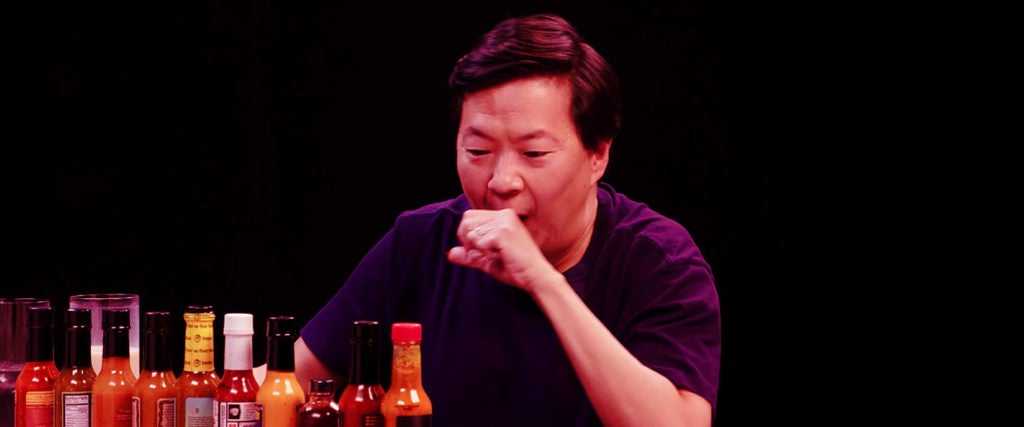Nearly 20 minutes into eating increasingly spicy wings during his appearance on Sean Evans’ YouTube series Hot Ones, Ashton Kutcher’s brain went haywire. After talking about being in the dictionary for Punk’d and the Guinness Book of World Records for Twitter followers, he starts to say, “At some point as a kid if you told me…,” only to stop himself to grunt, grimace and twist his body away from the camera.
The spice of the hot wing is undoubtedly running its course through the taste receptors on his tongue, into his brain and fucking shit up accordingly. Of course, this is a regular occurrence on Hot Ones. With all due respect to Evans’ excellently researched questions, the increasing amount of Scoville units in each hot sauce tends to force celebrities like Kutcher, Paul Rudd, Rihanna and Kristen Stewart to answer questions with a level of honesty they might have otherwise avoided.
“The hot sauce is the disruptive element. It’s designed to knock our celebrity guests off their PR-driven flight pattern,” Evans told the Wall Street Journal in 2018. “I’m going up the mountain with you, so it’s a bonding experience. By Wing Six, we’re best friends.”
What is it, though, about spicy food that gets Evans’ guests to speak with such candor and raw emotion — to get Wanda Sykes to say, “I’m ready to confess to shit I haven’t even done”; Pete Davidson to weep in delirium; and Seth Meyers to admit he wishes he could “go to commercial” during boring conversations in real life like he does on his show?
According to Uma Naidoo, nutritional psychiatrist at Harvard Medical School and author of This is Your Brain on Food, it mostly has to do with how each individual’s brain interprets the heat. Research using brain imaging shows that “tasting and ingesting the heat of chili peppers, or capsaicin, activates a region of the brain called the insula, which is known as the primary taste area,” she explains. “This implies the heat of chili peppers is perceived as a taste sensation.”
But it doesn’t stop there — that’s merely what differentiates it from the pain of, say, sitting on increasingly sharp thumbtacks. “Spicy foods may activate pain receptors, as well as opioid receptors, making you feel relief,” Naidoo explains. All those forces colliding can be “emotionally overwhelming to the system, which can make people feel more anxious, or more disinhibited,” she adds. “It could even lead to someone feeling euphoric.”
Interestingly, however, she’s sure to point out that “spice on its own is unlikely to make you say or not say things.” Likewise, she continues, “Euphoria and pain could overwhelm someone and make them say things that are unusual, but there are plenty of people for whom this doesn’t apply.”
And so, again, it ends up being more of an individual thing than not. For instance, she cites Justin Timberlake’s Hot Ones appearance: “He has amazing tolerance, probably because he grew up being used to eating spicy food.”
In the end, that’s the beauty of Hot Ones. One way or another, Evans will get his guests to reach a level of spice they’re not used to as they work their way up the Scoville meter. So while Timberlake might’ve handled the heat better than most, gritting his way through the hottest sauce — he still ended the interview dizzy, asking if he’d just partaken in a health hazard, sweating and screaming, “NO WATER BITCHES!!! NO WATER!!!”
It doesn’t get any more honest than that.

